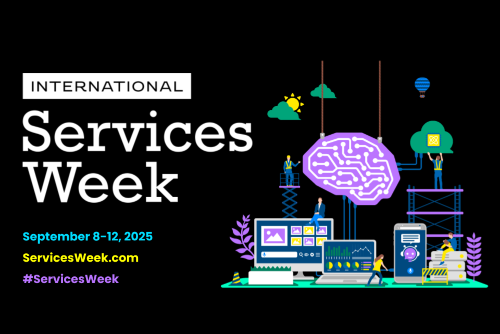Charting the course for Pragmatic AI adoption

When the Ford Model T debuted in 1908, few appreciated how profound its impact would be. Beyond disrupting transportation, it revolutionized city layouts, reshaped the environment, and transformed entire industries.
AI is having its Model T moment. Just look at the investments companies are making. Gartner Inc. forecasts (via CDO Magazine) that global spending on AI software will increase from $124 billion in 2022 to $297 billion in 2027, a 19.1% CAGR.
Embracing AI is no longer about making a strategic choice. It’s about the basic survival of your business. Given the impact today’s investments will have, avoiding AI’s distractions and not making knee-jerk decisions that offer little more than entertainment value is important. While others obsess over which silken AI voice they want to speak to them (just not Scarlett Johansson’s), your business should be focused on how to deploy AI pragmatically and in ways that can deliver immediate value.
Our pragmatic AI philosophy follows three key principles:
- Deployable. AI needs to be widely distributed across the workforce and integrated into the business rather than being confined to isolated use cases.
- Actionable. AI should surface information that drives decisions and has a tangible impact on the business.
- Closed loop. AI deployed should be part of a system where the outcomes of AI models continuously improve the models themselves, facilitated by structured datasets within the organization.
Despite the obvious benefits of adopting AI, doing so strategically and pragmatically can be a daunting prospect. Our 2024 Global Service Dynamics Report revealed that, apart from the state of the economy, adapting to AI is expected to be the top business challenge—surpassing competition and the shortage of skilled professional services labor.
The challenge is surmountable. Using a straightforward model to assess your current AI maturity level will allow you to identify your greatest weaknesses and guide AI investments that enhance your growth and ensure your survival.
The Pragmatic AI Maturity Model
The practice of deploying AI that is deployable, actionable and closed-loop is a journey that requires careful planning and gradual progression. You can’t expect to master the approach overnight. Each layer builds upon the success and maturity of the one before it.
To know where you want to go requires that you know where you’re starting. How do you measure your organization’s current level of AI readiness?
That’s where the Pragmatic AI Maturity Model comes in, providing a five-stage taxonomy for understanding your organization’s AI competence and how to climb the ladder successfully with more advanced AI use cases.
Here are each of the five stages, explained.
Stage 1: Initial
Isolated deployments of discrete AI technologies characterize this stage. The data environment is messy, with fragmented data and systems heavily reliant on spreadsheets and siloed tools. A typical AI use case in this stage is asking ChatGPT to generate basic content or summarize conversations. The AI tools used do not require access to internal data for their operations. Most organizations sit here today.
Stage 2: Repeatable
This stage is characterized by productized deployments of AI, where stand-alone solutions have AI integrated into them. Organizations begin to integrate more cohesive data practices but still face challenges in connecting operational data. The focus is on structuring data to start leveraging more advanced AI tools and technologies.
From a data posture standpoint, organizations have some structured data with good fidelity contained in multiple systems. However, there is still no central repository for holistic insights. Organizations that have seen initial successes with AI make up the majority at this stage.
Stage 3: Controlled
These organizations have established a unified data strategy, consolidating transactional and operational data into a single repository. This structured data aggregation allows for reasoning over data beyond individual departments or functions.
At this stage, organizations can use AI for more sophisticated tasks such as basic predictive analytics. Moderate use of generative AI and limited use of predictive AI become possible, as this is the first point where organizations can employ AI to make highly accurate predictions. While many organizations believe they are here, most are mistaken.
Stage 4: Optimized
In the fourth stage, organizations have robust data infrastructures in place that enable the use of advanced AI models for complex predictions and insights. AI is integrated into business processes, supporting real actions and enhancing decision-making and operational efficiency. Data and transactional systems exist within the same platform, allowing for real-time updates and seamless integration of AI-driven insights into daily operations. Organizations in this stage today have been putting in strong, consistent work for at least the past five years.
Stage 5: Continuous Improvement
Organizations in this final stage operate in the ideal state: a closed-loop system with clean, real-time data that continuously improves AI models. Predictions support actions, and those actions continuously refine predictions—creating a cycle of improvement. AI tools are highly actionable and deployable, driving significant business outcomes and efficiencies.
Achieving this phase requires a single real-time platform with strong data governance policies, ensuring seamless integration and robust data management. I’d estimate there are fewer than 20 organizations globally at this stage.
Data underpins the path to Pragmatic AI
Whichever stage you’re currently at, success is well within your reach. Just be skeptical of software providers that promise a warp-speed trip to Stage 5.
Start by assessing your current level of AI readiness using this maturity model, and then map a strategic course to advance your organization through each stage. Emphasize establishing a foundation of clean, accessible, real-time data upon which future AI deployments can be built.
Then, as you continue to make investments and decisions along the way, always reflect on whether you’re following pragmatic AI principles. Are we making AI more deployable? More actionable? More closed-loop? If the answer is no, you may be headed down the wrong path.
Success is rarely linear. Your journey may get bumpy at times, but the rewards are undeniable. Now is the time to seize the moment to shape your AI future—pragmatically.
Recent Articles
Maximize your Salesforce investment with Certinia






